HARDY BROTHERS BEST FLY BOXES?
At long last I have something to write about in an article that I hope the readers of the Antique Tackle Observer will find of interest.
I have just returned from an eight-hour round-trip drive, which took me through pounding West Coast rain from Vancouver, BC, to Portland, Oregon, and back.
I left my home in the morning darkness at 5:00 a.m. after receiving a telephone call the previous week from a fellow tackle collector who had found a “nice” Hardy fly box.
My initial interest was limited, and I posed the query “How is the exterior, free of dents?”.
He replied, “Well it’s not made of metal, it’s made of wood”. My heart skipped, I sat up at my desk and composed my reply, “What type of wood?” “Mahogany” was the counter. “it’s the ‘Unique’ cabinet, I’ve seen it in a book”.
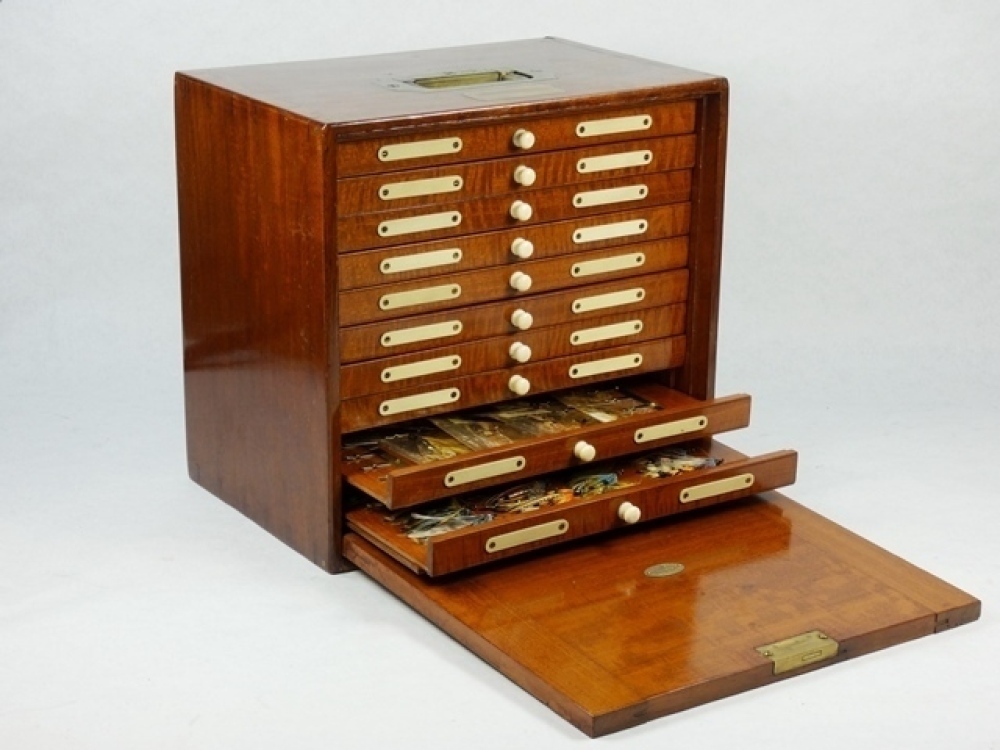
Now no one had to pound me between the eyes with a mallet for the alarm bells to go off. With the calmness of 007 and the swiftness of his Aston Martin DB7, I was off down the highway in my Mazda. I was armed with the knowledge of the example which had just sold at Neil Freemans’ most recent and historic sale. Need I say more? (see A.T O. Oct./ Nov. 1996 page 9) (£7,000.00)
Firstly, I was pleased to find my wildest thoughts during my four-hour drive to Oregon – and I had plenty of time to twist with mind games during my long drive – for once were not a complete waste of time or petrol. I know every true collector has experienced this and it seems to be more and more the norm. (on both sides of the pond)
We met and the cabinet was introduced to me. It was stored in a heavy durable cotton case that had leather hide comers. I am certain that the case is not original as it has no name tags or marks bearing the maker’s name.
We know Hardy’s were not accustomed to leaving their names off items, especially high-priced speciality goods such as this cabinet. There is also no mention of a cotton case in any catalogue from 1903 to 1939.
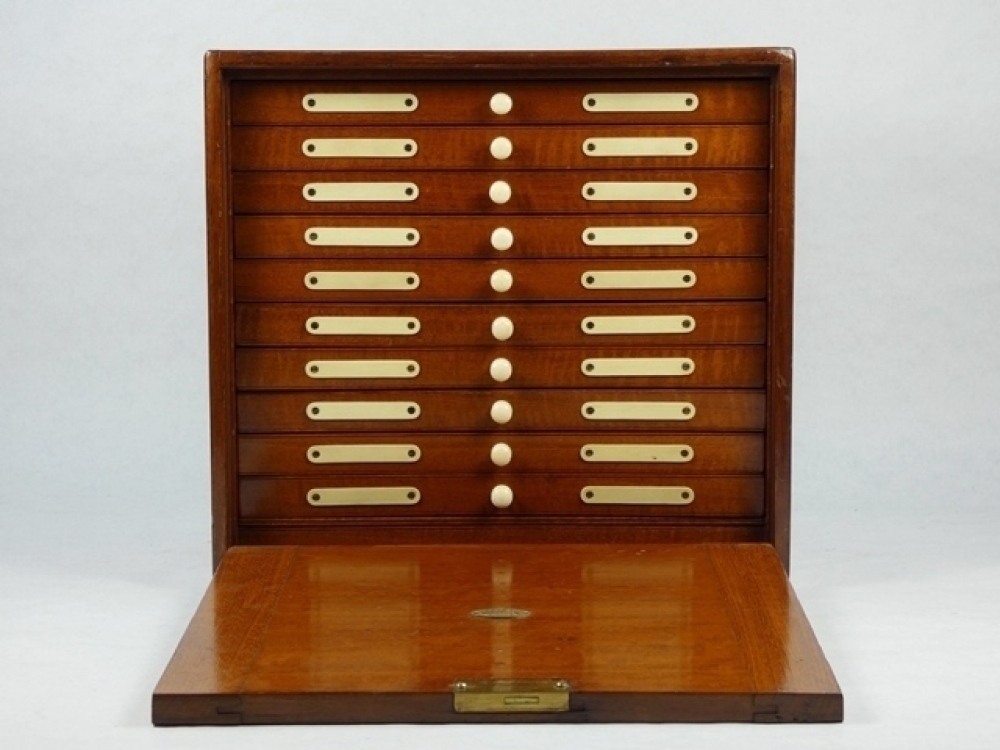
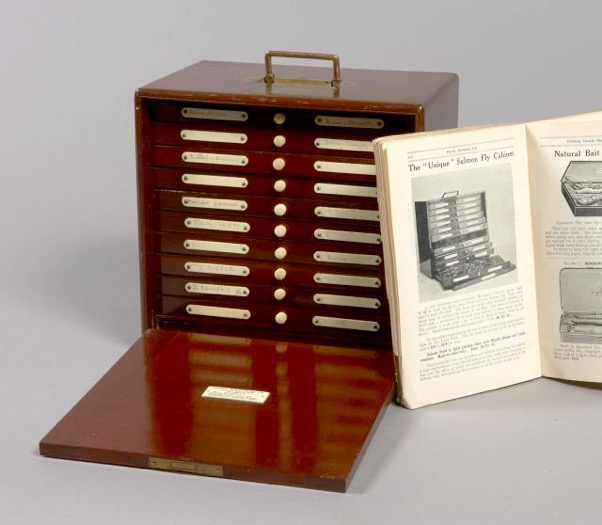
I believe the burlap bag was a convenient fit but possibly an old projector case. So be it but if any reader knows otherwise please let me know.
When I returned home, I removed the gleaming box from its home of many years only to be met with that familiar strong pungent scent of mothballs long since removed.
I placed the simple cabinet key into the brass escutcheon and opened the fall front door. Here in detail is what I observed.
The cabinet exterior is simple in design and this is truly part of its overall beauty and function. The fall-style door is made of solid mahogany (a tropical hardwood) as is the entire cabinet. The door is made of three pieces, two one-inch side bands and a centre portion which houses the solid brass locking unit. The door is secured to the main box with two six-screw hinges. The door has on the inside surface an oval nickel silver disc stamped, Hardy Bros. Makers Alnwick.
There are ten drawers each with a tiny grained ivory button or “bun” button to pull open each fly tray. The two ivorine/ivory fly name plates on each drawer are fastened into position with two perfectly lined up flush-mounted brass screws. (40 screws in total, all in the same position)
The moth tray has five 1/4 inch perforated holes and is also in Mahogany.
The cabinet exterior excluding the door consists of five mahogany slabs, each 1/3 inch thick. These slabs are finely dove-tailed and fastened with two tiny counter-sunk brass screws on each side panel.
The top deck has a beautifully recessed brass carrying handle attached with three counter-sunk screws.
The nickel silver fly clips are secured to very slim wood drawers with tiny domed brass screws. This cabinet holds 326 flies in total.
There is also a brass presentation plaque set into the dark ruby-red wood directly in front of the handle. Total box dimensions are 10.1/8 ins X 9 3/4 ins. X 6 3/4 ins. and the wood is fully seasoned Tahitian Mahogany. Box weight is 7 lbs. 4 oz.
This fly cabinet has a sketchy history. It was purchased in 1962 by a wealthy American who ordered six, yes six AHE Wood rods from Hardy’s Pall Mall during a business trip to London.
When he expressed an interest in “only the best” the sales clerk realised that money was no problem and asked him to return the next day. The American came back bought the cabinet second hand and returned to America. This gentleman is now in his eighties and felt it was time to part with an old friend. I’m bloody glad he did!
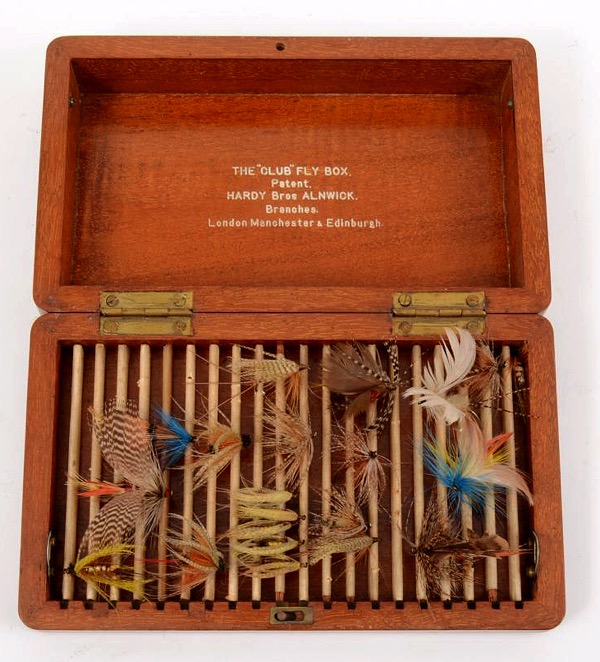
The second box highlighted in this article is the equally rare if not rarer “Club” Reservoir box which measures 9 1/2 ins. x 3 1/2 ins. x 2 ins.
It has a fascinating history, also turning up in Oregon four years ago at a regional tackle show in the hands of a Heddon collector. I was extremely fortunate to buy both a mint Reservoir and the May Fly Club boxes. These boxes cost, in 1907, twelve shillings and sixpence for the smaller May Fly box and the huge sum of twenty-five shillings for the fancy double-sided reservoir box.
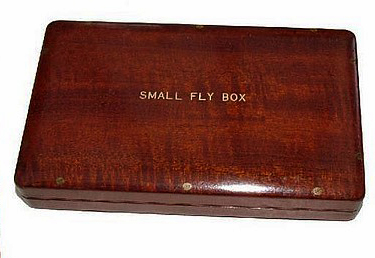
Now both my boxes are a lovely light ginger colour and differ slightly from the pictures shown in the pre-1910 Hardy catalogues. The 1903 Hardy catalogue shows flies attached to paper bars, but my boxes have cork bars attached to hardwood inserts. This must therefore be a later improvement, a Hardy hallmark.
The reservoir box is ultra-light in construction and as mentioned a lovely full-grain copper coloured Mahogany (Think of Robertson’s Seville Marmalade)
The lightness of these boxes I’m sure adds to their scarcity, as one good knock and you would have some very expensive firewood. I have no doubt very few survived a trip to the river and back home again unscathed.
The two lids, both top and bottom are slightly domed and fitted into position with fourteen tiny brass screws holding the box top and bottom together with the lid rims. The top lid is elegantly marked “RESERVOIR FLY BOX” in white lettering.
The lids are secured to the main box body by two four-screw hinges. (two sets on top and two sets on bottom)
The lids lock in place with tiny “J” hook closures at each end of the box.
The top lid interior is marked “THE ‘CLUB’ FLY BOX Patent HARDY Bros. ALNWICK Branches London, Manchester & Edinburgh”
The box has 28 cork and wood bar inserts that clip into place and lock solidly due to the complicated brass mechanism which moves to lock the cork and wood bars into place. This finger lock is located on the front portion of the main box.
The box is of fine dove-tailed construction and pinned with brass dowels. Total weight is a mere 10 ounces. The May Fly box weighs 3 ounces.
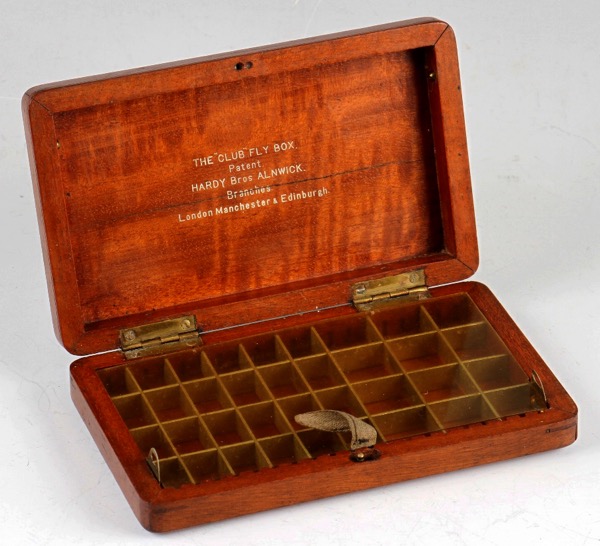
I do hope my description of these Hardy fly boxes is of interest to avid collectors. I can assure you that I know of no other tackle maker in the world who has ever made a fly box that can even come close to rivalling these beauties.
The fact that these examples of early Hardy fly boxes exist is not only a testament to their willingness to be the best, but as miniature furniture pieces they can stand against the best, Does anyone have the B.B.C. television phone number for the Antiques Road Show?
All the best from the Western Angler and the Canadian Colony.
Original Article Craig Dixon.